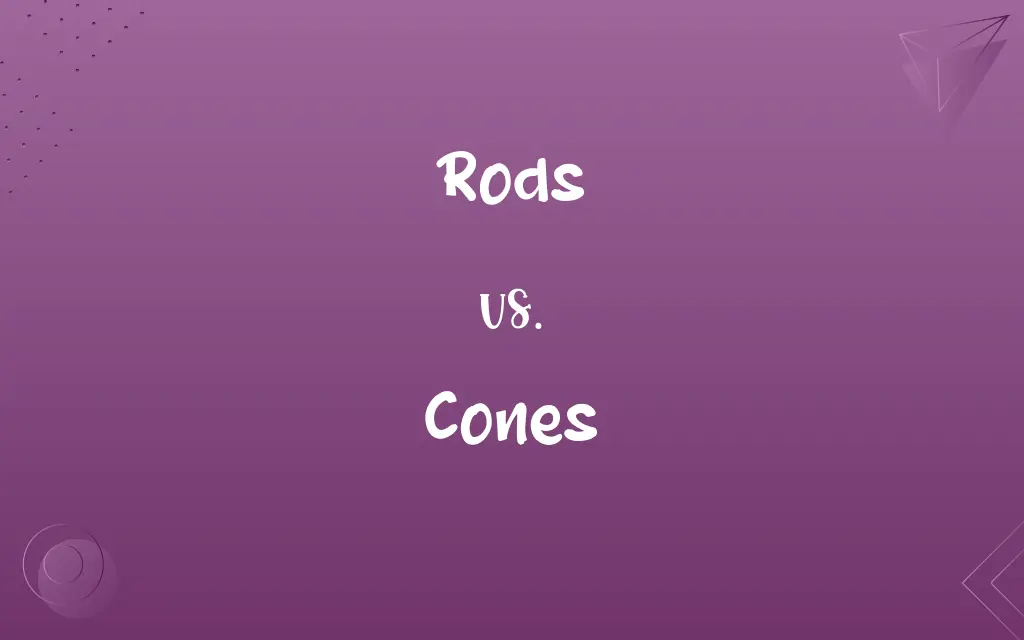Rods vs. Cones: Know the Difference

By Shumaila Saeed || Updated on December 25, 2023
Rods are photoreceptor cells in the retina sensitive to low light levels, while cones detect color and work best in bright light.

Key Differences
Rods are highly sensitive to light and enable vision in low-light conditions, playing a key role in night vision. Cones, conversely, require brighter light and are essential for color vision and detailed visual perception.
Shumaila Saeed
Dec 11, 2023
Rods are more numerous and predominantly located in the peripheral regions of the retina. Cones are concentrated in the central retina, particularly in the fovea, where they provide high-resolution vision.
Shumaila Saeed
Dec 11, 2023
All rods are similar in type and do not provide color differentiation. Cones come in three types (red, green, blue) and are responsible for the perception of a wide range of colors.
Shumaila Saeed
Dec 11, 2023
Rods adapt better to changes in light levels, particularly in dim environments, allowing for night vision. Cones adapt to bright light conditions and are less effective in the dark.
Shumaila Saeed
Dec 11, 2023
Rods contribute to peripheral vision and motion detection but lack the detail and sharpness provided by cones, which are crucial for high visual acuity and detailed central vision.
Shumaila Saeed
Dec 11, 2023
ADVERTISEMENT
Comparison Chart
Light Sensitivity
Highly sensitive, function in low light.
Require bright light, less sensitive in the dark.
Shumaila Saeed
Dec 11, 2023
Color Perception
Do not distinguish colors.
Enable color vision with three types.
Shumaila Saeed
Dec 11, 2023
Distribution in Retina
More numerous, mainly in peripheral retina.
Concentrated in central retina, especially in fovea.
Shumaila Saeed
Dec 11, 2023
Light Adaptation
Better adapted to dim light, enable night vision.
Adapt to bright light, less effective in darkness.
Shumaila Saeed
Dec 11, 2023
Visual Acuity
Provide peripheral vision, not sharp detail.
Crucial for high-resolution and detailed vision.
Shumaila Saeed
Dec 11, 2023
ADVERTISEMENT
Rods and Cones Definitions
Rods
Low Light Photoreceptors
Rods allow us to see in dimly lit environments.
Shumaila Saeed
Dec 03, 2023
Rods
Single-Type Photoreceptors
All rods are similar and lack color differentiation.
Shumaila Saeed
Dec 03, 2023
Cones
Bright Light Photoreceptors
In bright light, cones are more active than rods.
Shumaila Saeed
Dec 03, 2023
ADVERTISEMENT
Cones
Central Vision Enhancers
Cones provide the sharpness in our central vision.
Shumaila Saeed
Dec 03, 2023
Rods
Peripheral Vision Contributors
Rods play a major role in peripheral vision.
Shumaila Saeed
Dec 03, 2023
Cones
Three Types for Colors
There are three types of cones for red, green, and blue vision.
Shumaila Saeed
Dec 03, 2023
Cones
The surface generated by a straight line, the generator, passing through a fixed point, the vertex, and moving along a fixed curve, the directrix.
Shumaila Saeed
Dec 01, 2023
Rods
An often expandable horizontal bar, especially of metal, used to suspend household items such as curtains or towels.
Shumaila Saeed
Dec 01, 2023
Cones
The figure formed by a cone, bound or regarded as bound by its vertex and a plane section taken anywhere above or below the vertex.
Shumaila Saeed
Dec 01, 2023
Cones
Something having the shape of this figure
"the cone of illuminated drops spilling beneath a street lamp" (Anne Tyler).
Shumaila Saeed
Dec 01, 2023
Cones
A unisexual reproductive structure of most gymnospermous plants, such as conifers and cycads, typically consisting of a central axis around which there are scaly, overlapping, spirally arranged sporophylls that bear either pollen-containing structures or ovules.
Shumaila Saeed
Dec 01, 2023
Cones
A similar, spore-producing structure of club mosses, horsetails, and spikemosses.
Shumaila Saeed
Dec 01, 2023
Cones
A reproductive structure resembling a cone, such as the female inflorescence of a hop plant or the woody female catkin of an alder.
Shumaila Saeed
Dec 01, 2023
Rods
One of the horizontal elements in a truss system underneath a rail car, especially a freight car.
Shumaila Saeed
Dec 01, 2023
Cones
(Physiology) One of the photoreceptors in the retina of the eye that is responsible for daylight and color vision. These photoreceptors are most densely concentrated in the fovea centralis, creating the area of greatest visual acuity. Also called cone cell.
Shumaila Saeed
Dec 01, 2023
Cones
Any of various gastropod mollusks of the family Conidae of tropical and subtropical seas that have a conical, often vividly marked shell and that inject their prey with poisonous toxins, which can be fatal to humans. Also called cone shell.
Shumaila Saeed
Dec 01, 2023
Rods
A stick or bundle of sticks or switches used to give punishment by whipping.
Shumaila Saeed
Dec 01, 2023
Rods
Power or dominion, especially of a tyrannical nature
"under the rod of a cruel slavery" (John Henry Newman).
Shumaila Saeed
Dec 01, 2023
Cones
Detail Vision Providers
Cones are responsible for seeing fine details.
Shumaila Saeed
Dec 03, 2023
Rods
A linear measure equal to 5.5 yards or 16.5 feet (5.03 meters). Also called pole2.
Shumaila Saeed
Dec 01, 2023
Rods
The square of this measure, equal to 30.25 square yards or 272.25 square feet (25.30 square meters).
Shumaila Saeed
Dec 01, 2023
Rods
(Anatomy) Any of various rod-shaped cells in the retina that respond to dim light. Also called rod cell.
Shumaila Saeed
Dec 01, 2023
Rods
Night Vision Cells
Thanks to rods, humans can see shapes and movement at night.
Shumaila Saeed
Dec 03, 2023
Repeatedly Asked Queries
What are rods?
Rods are photoreceptors in the retina sensitive to low light.
Shumaila Saeed
Dec 11, 2023
How many types of cones are there?
There are three types of cones for red, green, and blue light.
Shumaila Saeed
Dec 11, 2023
Which photoreceptor is more numerous?
Rods are more numerous than cones in the human retina.
Shumaila Saeed
Dec 11, 2023
Where are rods located in the retina?
Rods are mainly located in the peripheral regions of the retina.
Shumaila Saeed
Dec 11, 2023
Are there diseases that affect rods or cones?
Yes, diseases like retinitis pigmentosa affect rods, and macular degeneration affects cones.
Shumaila Saeed
Dec 11, 2023
Do rods and cones work together?
Yes, they work together to provide a full range of visual capabilities.
Shumaila Saeed
Dec 11, 2023
What is the function of cones?
Cones detect color and provide high-resolution vision in bright light.
Shumaila Saeed
Dec 11, 2023
Do rods contribute to detailed vision?
Rods lack the ability to provide detailed vision, which is a function of cones.
Shumaila Saeed
Dec 11, 2023
Are cones active at night?
Cones are less effective in the dark and require brighter light.
Shumaila Saeed
Dec 11, 2023
What is the role of rods in vision?
Rods are essential for night vision and peripheral vision.
Shumaila Saeed
Dec 11, 2023
Can someone be born without cones?
Yes, a condition called achromatopsia involves the absence or malfunction of cones.
Shumaila Saeed
Dec 11, 2023
Do cones help with night driving?
Cones are less effective at night; rods primarily aid in night vision.
Shumaila Saeed
Dec 11, 2023
Can cones function in low light?
Cones are not as effective in low light as rods.
Shumaila Saeed
Dec 11, 2023
How do rods and cones send signals to the brain?
They convert light into electrical signals sent to the brain via the optic nerve.
Shumaila Saeed
Dec 11, 2023
What is the fovea?
The fovea is the central part of the retina, where cones are densely packed.
Shumaila Saeed
Dec 11, 2023
Is the number of rods and cones the same in everyone?
The ratio varies, but generally, there are more rods than cones in the human retina.
Shumaila Saeed
Dec 11, 2023
Do rods adapt quickly to light changes?
Rods adapt to light changes but not as quickly as cones.
Shumaila Saeed
Dec 11, 2023
Can rods detect motion?
Yes, rods are sensitive to motion, especially in low light.
Shumaila Saeed
Dec 11, 2023
How do cones affect color blindness?
Color blindness often results from defects in cone cells.
Shumaila Saeed
Dec 11, 2023
Share this page
Link for your blog / website
HTML
Link to share via messenger
About Author
Written by
Shumaila SaeedShumaila Saeed, an expert content creator with 6 years of experience, specializes in distilling complex topics into easily digestible comparisons, shining a light on the nuances that both inform and educate readers with clarity and accuracy.









































































